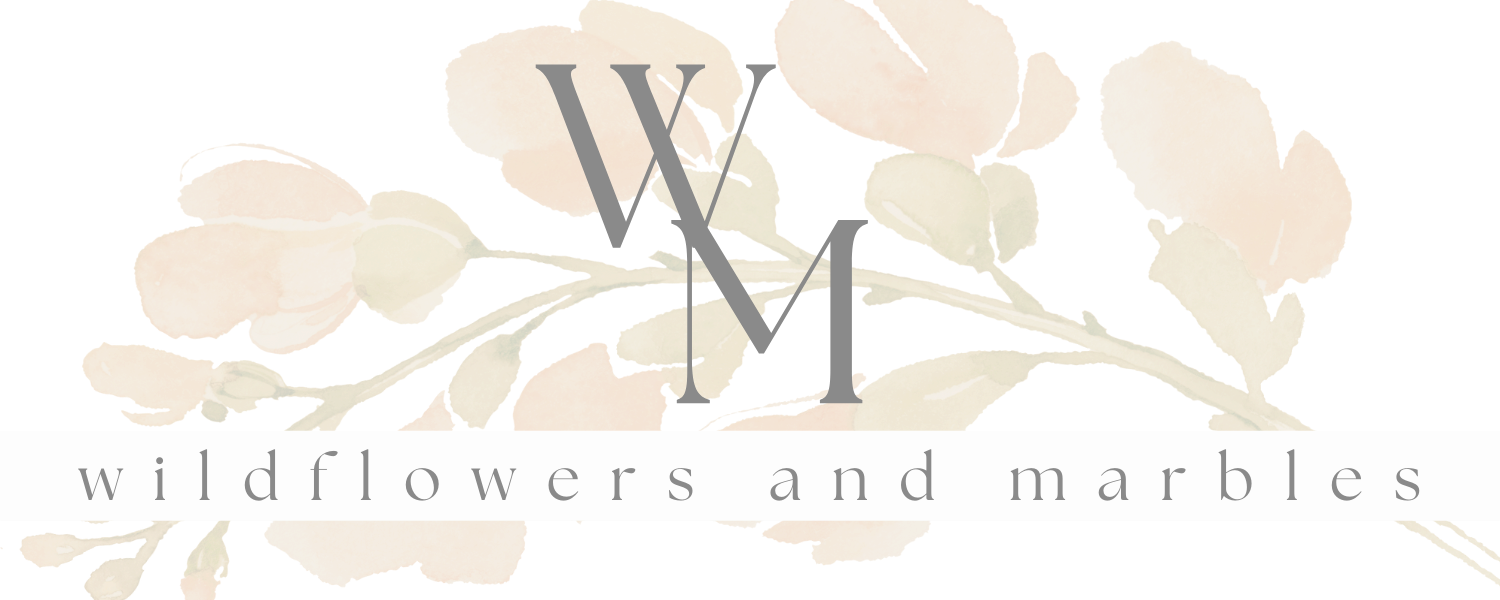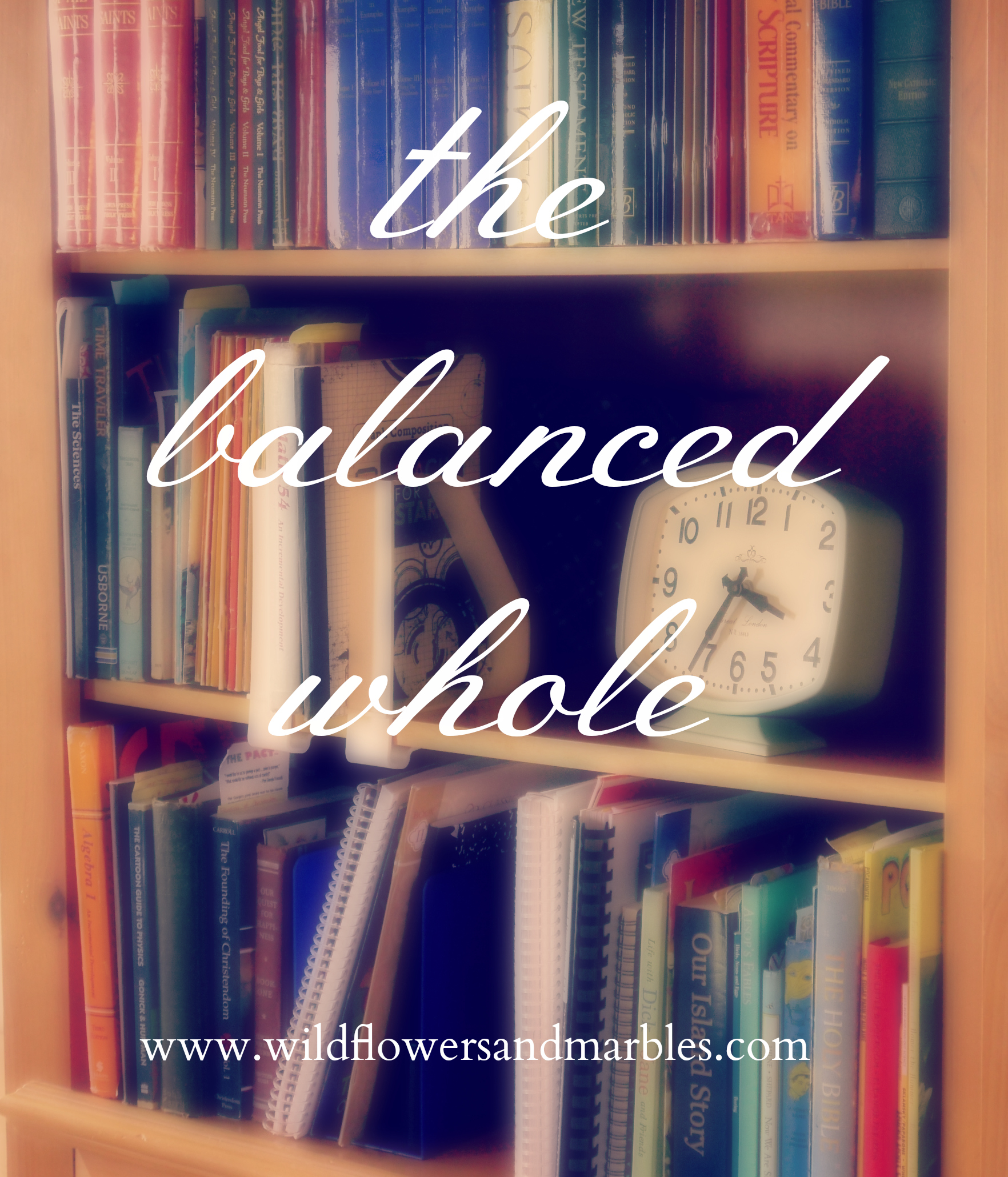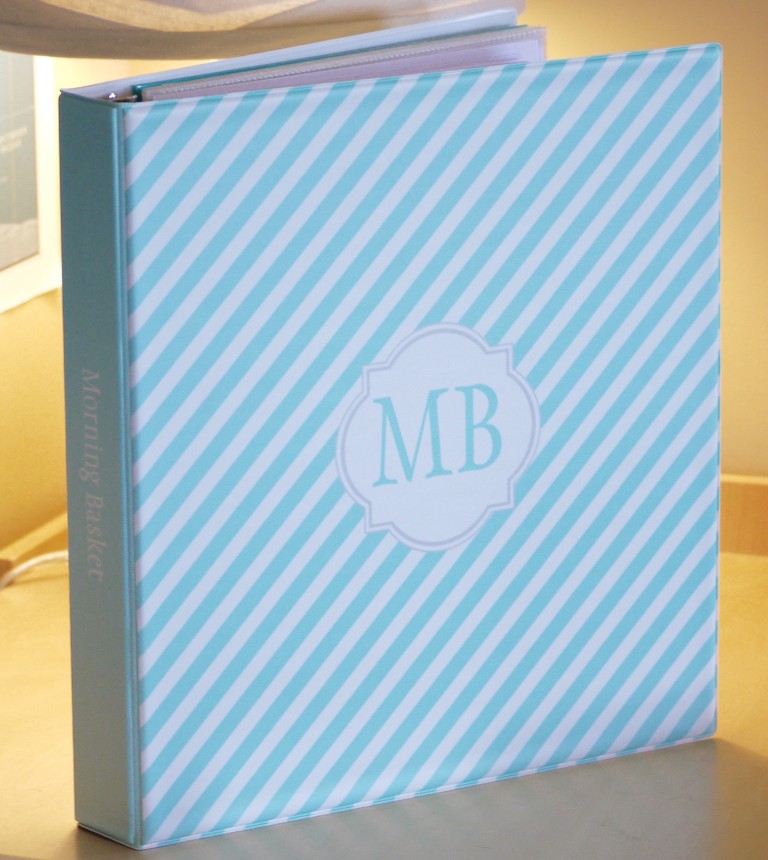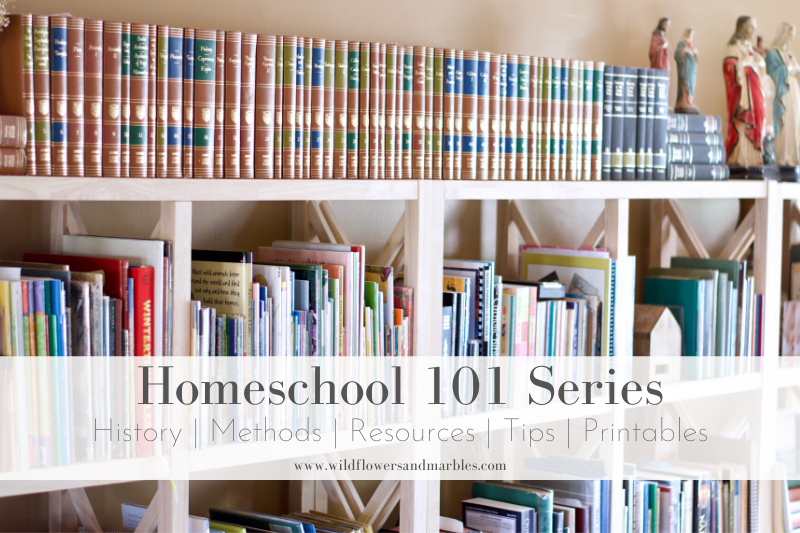The Balanced Whole In a Charlotte Mason Education
In Memoriam: Charlotte Mason, (available as a free download to your ebook here) is a book of tributes written by many of Miss Mason’s peers and friends who each share their unique remembrances of Charlotte Mason. As part of the remembrances, many of which offer highly applicable insight into Charlotte Mason’s method of education, some of the children educated through the Parents National Education Union (PNEU) schools shared their thoughts on Miss Mason and her methods and philosophy. In a chapter simply entitled, The Children, one of Miss Mason’s students reflected:
“…it is only when used as a balanced whole that P.N.E.U. methods give their best results.”
Isn’t that a lovely thought? A balanced whole. It is a thought worthy of a little exploration.
In receiving your kind emails, many of you write looking for insight because you hope to move toward a more Charlotte Mason education. What a noble and worthwhile pursuit! I can say this with great conviction because each time I re-read Charlotte Mason, in her own words, I find new insight, new treasures which were there all along, but present themselves as new and fresh to me, uncovered in a sense.
Miss Mason refers to her desire to share her philosophy as seeking to reveal an “open secret”, that is to say, these methods which Miss Mason spent such time and insightful research elaborating aren’t really hers to claim at all, they are universal! Open and simply awaiting illumination. What Miss Mason has done for us, from which we all may benefit, is relate this “open secret” in an inspiring way, and a way that is practical and instructive. What this “open secret” is NOT is a collection of parts which can be fitted in here or there. Oh dear. If I’m not popular right now…read on…I’m going to challenge you a bit on this.
A Charlotte Mason education is so much more than a formula and a booklist, and it’s probably high time I underline that a bit here. I enjoy sharing my booklists with you so much because in the sharing I hope that an idea-shared might begin to take its own shape in your mind, and translate into your own home in a unique and pleasing way. In much the same way that Miss Mason shares her “open secret”, I share ideas here because it gives me such joy to do so, and because these ideas and the way they live themselves out in my home certainly isn’t mine to claim; these ideas are available to anyone. The living out of Charlotte Mason’s methods and ideas are a reflection of the balanced whole of a Charlotte Mason education.
When speaking of a Charlotte Mason education, there are two things to keep in mind – method and philosophy.
The methods of a Charlotte Mason education
…can be thought of as instruments or tools in your toolbox, and they would be things like narration, dictation, short lessons, generous time spent in the out-of-doors (nature study), living books. These instruments, or methods, can’t be totaled up to equal the whole though, there is more.
Do you want a sure and certain recipe for burn out? Plug a few Charlotte Mason methods into a structured and pre-packaged curriculum. What does this look like?
- Oral narrations AND reading comprehension questions
- Written narrations AND book reports and essays (in elementary and middle school…high schoolers must learn to polish some of these writing skills, but written narrations naturally springboard into these more sophisticated writing skills)
- Dictation lessons AND spelling lists/vocabulary quizzes
- Living books AND emphasis on dry texts full of fact blurbs
I’m not going to be popular for saying this, but Merciful Heavens(!!!), I briefly lived the outcome of such an ill-fated match. It wasn’t pretty. Why not? Because for one thing, I was adding parts that are meant to be lived out as part of that “balanced whole”, and the other half of that whole is NOT a structured pre-packaged curriculum.
After the flames have died down from your burn out…one begins to wax philosophically about why a Charlotte Mason education really isn’t all that, and apparently doesn’t work as proclaimed. It’s the nebulous, not-really-applied Charlotte Mason ideas that are always blamed.
“See…I knew it couldn’t be that simple and actually work. We really do need 30 vocabulary words and 30 spelling words and reading comprehension questions and long multiple choice exams…and…and…and…because that’s what everyone says we must do if we’re REALLY going to educate our children. Enough of this business of just using ‘living books’.”
What is extraordinarily sad is that (classical) education, for centuries, never used these methods of stuffing and sorting. Classically, education happened with the same methods employed in Charlotte Mason’s schools: reading of worthy literature, narration, dictation, observation, time spent out of doors – opportunities to ask questions.
Burn out happens because Charlotte Mason’s methods are extremely rigorous. Rigorous = thorough, exhaustive, accurate. On the surface, bereft of Teacher’s manuals and assigned book reports, a Charlotte Mason education looks as if it’s a “lite” version of education. But, don’t allow this surface appearance to deceive. On its own, a Charlotte Mason education works in a cohesive, efficient way, but this means that Charlotte Mason on top of a boxed, structured curriculum is redundant and over-burdensome. It is the anti-thesis of what is possible with a harmonious Charlotte Mason education that reflects a balanced whole.
The philosophy of a Charlotte Mason education informs the methods
Her philosophy is probably best summed up in her own motto: “Education is an atmosphere, a discipline, and a life.” She believed very deeply in the importance of relationships within education – both those formed between persons, and also those that a child formed with an idea. A child, in reading from living, whole ideas, makes connections in their learning; they begin to act and express what they’ve learned in tangible, hands-on ways, and these expressions deepen the relationship they have with an idea. It is, in every sense of the word, living.
I dare you to try this with your standard textbook-authored-by-a-herd-of-professional-peoples-in-authority-that-ensured-that-the-scope-and-sequence-for-the-grade-level-has-been-met-through-their-chapters. I double-dog dare you. Hand a child a blurb-filled text book and ask them to tell you what they remember? What did they learn from their reading? Were they excited? Can they tell you what they read about 6 chapters ago? Children who encounter living ideas regularly can tell you what they learned about 6 chapters ago, 6 months ago, even 6 years ago. Because they formed relationships with ideas. That is education that is a life!
Still wondering what this looks like with the balance of the whole? Let’s go back to Charlotte Mason’s student who wrote in 1923:
…it is only when used as a balanced whole that P.N.E.U. methods give their best results.”
What must one do to achieve the“best results” from a Charlotte Mason education? Apply the methods with Charlotte Mason’s ideas, with her philosophy, and let them yield fruit…over time. The methods work WITH Charlotte Mason’s philosophy and separating the two nullifies any expectation of a harmonious, peaceful experience with a fruitful result. These two things together foster “a balanced whole” and a unique harmony and this is what allows a Charlotte Mason education to really sing out with depth in a wide and generous way. And flourish. If you’re looking for a bulleted and brief teaser sort of list, you can read her 20 principles. It’s a start.
A Charlotte Mason education, applied as a balanced whole, is:
- rigorous without compromising gentleness
- varied and generous without being superficial
- efficient while remaining utterly simple, lovely and purposeful
- living and whole: an expression of ideas and persons
- unique and joyful
It fosters self-education and nurtures relationships between persons and between ideas. It is not a static curriculum that can be captured, nor does it rely on anything more than a child’s keen and attentive mind meeting an author who shares passionately between the covers of a living book. This is one of the reasons some (many) home educating parents look at it and say,
Uh, no thanks. I need something that is plug and play. I’m looking for someone to tell me what to do! I certainly can’t teach beyond the basics – what if I MISS SOMETHING?!”
Oh, what a joyful alongside-journey those parents are missing! The rich and varied experiences and learning-together that happens as part of a Charlotte Mason education are precious treasures. Will you need to read a little, to apply yourself, work hard? Yes. But you’re going to be working hard at this whatever you do! Roll up your sleeves, read, and enjoy this amazing vocation of home education in relationship WITH your children, as part of the rich experience of wonder!
Lest you think that this “balanced whole” equals inflexible or rigid, it does not. A Charlotte Mason education is practical and malleable to a remarkable extent. The instruments and tools (the methods) of a Charlotte Mason education meet the child – every individual child – right where they are and opens the door to ideas. The ideas communicate themselves through living books.
The life of the mind grows upon ideas.” (Charlotte Mason, Vol 2, p. 29)
It couldn’t be simpler.
A reading list for seeking to know and apply the balanced whole:
- Charlotte Mason Reviewed: A Philosophy of Education by Jenny King – My, but this is a delightful book to read if one is interested in Charlotte Mason’s philosophy of education! So unintimidating is this succinct little jewel, that it could easily be enjoyed over a cup of tea in an afternoon. If you’re looking for an introduction, this is the best. Jenny King was a Charlotte Mason trained teacher, graduating from Charlotte Mason college in Ambleside in 1935. {Update 2014: I’m excited to report that I’ve found a copy of the book in print, and available to purchase through Perimeter School Bookstore!}
- A Charlotte Mason Education by Catherine Levison – Catherine Levison’s books are my favorite books for summarizing and communicating Charlotte Mason’s methods and ideas with enough meat to hit the ground running. I have found over the years that many claim that what they communicate is “Charlotte Mason”, but often, what they communicate is really their translation of Charlotte Mason. This is absolutely fine, but I like clearly knowing if that is the case. In reading several summaries of Charlotte Mason over the years, as well as Charlotte Mason’s volumes, I prefer how Catherine Levison communicates Miss Mason’s ideas and how she clearly explains where (if at all) she deviates.
- More Charlotte Mason Education by Catherine Levison – my favorite book for illustrating Charlotte Mason in high school years and a great follow-up to her first book!
- A Literary Education by Catherine Levison
- When Children Love to Learn by Elaine Cooper
- For the Children’s Sake by Susan Schaefer Macauley
- The Original Homeschooling Series by Charlotte Mason – after you whet your appetite with a few good summaries, you’re going to have to dig into the originals. You can do this! Really! This is where you will find the treasure chest of ideas from Miss Mason’s own pen. Start with Volume 6! You’ll be starting with a fantastic perspective – the big picture. From there, work your way forward starting with Volume 1. Charlotte Mason’s insight is timeless.
- Simply Charlotte Mason for resources and DVD seminars that aid in the practical application.
So, thanks for remembering that when I joyfully share our booklists and our plans for a year, I seek (throughout the ordinary of our days) to apply these books and plans as part of the “balanced whole” of a Charlotte Mason education. There is such great joy within the expression and the fruit of that whole.








Thank you for these recommendations, Jen. We are beginning kindergarten with our firstborn in September and I have requested several of these books from the library!
Jen, AWESOME post! Thank you so much! I'm on the same wavelength this summer; that booklist I'm also done…waiting on Inter-library loan for Jenny King's book.
But all great points; I think I need to print this one and digest it further and APPLY it!
Wow! fantastic post! so much to mull and process. Going to be re-reading this a few times, inspired to hit the meatier books now:)
PS. Lovely new thumbprint pic, a different look though:)
I just wanted to add I just got through the Loan “The Story of Charlotte Mason” by Essex Cholmondeley and it's really helpful to put her work into context! Really wonderful book!
I'm so glad you mentioned “The Story of Charlotte Mason, Jenn! I'm eagerly awaiting that book as well as a lecture that Charlotte Mason gave entitled, “An essay towards a philosophy of education: A liberal education for all” which I finally found in the UK. It's such a hard book to find, so I am very excited to have found it!
Happy reading!!
Jen, just amazing! Your words give comfort to the journey I want to have with my children and the relationship I see forming with the balanced whole that Charlotte Mason laid down for us.
Thank you, once again! I was guilty of this at one time…burnout fodder.
It took a long time for me to stop trying to push too much into my head and at the same time not try and force-learn the kids in any kind of unnatural way. There was a time when I felt like the “homework police” would come a-knocking and how would I ever have anything to SHOW for their work? Hogwash. Right?
So much we do now is oh, so more intuitive and LIVING. I am still trying to knock out the kinks. The thing that gets me is this highschool thing…what is needed and what isn't. Especially since my eldests (the ones that broke me in as a teacher) have a few learning issues that need to be handled. Sometimes it is so necessary to slow down and listen to that small still voice of the Spirit.
I need to do more reading. Where do you think I should start in regards understanding more of expectations and planning for my highschool crowd?
Thank you all for your encouraging and kind words! I'm still waiting for the tomatoes to come flying from somewhere! LOL!!!
Donna Marie,
I hear you SO MUCH, sister!!
>> Sometimes it is so necessary to slow down and listen to that small still voice of the Spirit. << Nodding my head! Yes – thanks be to God for the still small voice! Stay tuned-in to that voice, ok?! And trust it!!!! Especially as you plan and live out those plans for your high schoolers! I'm sending you prayers as you discern and whittle out the wheat from the chaff in your planning! Now, the best place to start for highschool planning ala CM? Without a doubt, Catherine Levison's *More Charlotte Mason Education*!! She includes a very helpful chapter that really provided a little lift in confidence in mapping out my first high school plans last year. Really…it's just a little wider and a little deeper than it was the year before that (if you've been doing this CM thing all along). Reflect on last year – separate the worthless from the worthy. Build on the worthy and stretch out a little further from there. That's it. It really is as simple as that to me. That's it for my insight on high school planning! LOL! I will say that I have NEVER enjoyed CM more than I have in high school! What a sheer delight! Oh…one more resource, and I'm certain you know about it already – Harmony Art Mom does a fantastic job of blogging a CM high school experience. You have to scroll all the way down on her blog and link to her high school posts individually: http://harmonyartmom.blogspot.com/
Thanks Jen! Very timely post. How did you know I was wanting to dig a bit deeper into Charlotte's philosophy for the upcoming school year?!? 🙂 Very well written, no tomatoes here 😉
This is one of the best explanations and insights I've read! Thank you for sharing. I wish I learned from other people's past trials, but unfortunately I have to experience the trials before I can change my thinking. I'm keeping this nestled in my “someday” folder. You know, that collection of ideas that you are striving for, but can't seem to commit to today?
Blessings!
great post as always Jen, and inspiring as I move into planning for my oldest who is moving into 7th grade
Great post, Jen, thank you. After “flirting” with CM's methods and philosophy and reading a number of different interpretations and such for the last *ahem* 5 years or so, I finally decided to make the commitment and go for a full implementation – as far as I understand such things at this point! Our last term – our first since this decision – has been wonderful!! I can't underscore that enough.
I have also started reading Vol. 6 (thanks to your recommendation!) a few months ago and taking notes as I go. I feel so grown up, reading CM in her own words. I feel like I've graduated to a whole new level! *grin* And doing notes and written narration as I go has been so helpful. Imagine that, CM's methods work for adults too!
I never quite made the mistake you mention where you try to do the belt and suspenders approach – narration and comprehension questions, etc. Instead I was missing the whole idea of education as a science of relations. Everything felt so boxed off and compartmentalized. Some things were about right, but others were entirely wrong… so nothing held together and it felt like too much work and just too much in general! I'm so glad I decided to reboot for our last term and got to see the fruit of that decision. And I'm very excited about planning and moving into the next year!
Amber,
Your comment was striking! I'm so glad you're reading CM and enjoying her! I take notes and do written narrations when I read CM as well, but I have loved that because I invariably go back to my notes from time to time and find them helpful! Make sure you keep them together in a notebook so you don't lose them! I keep an expanding file folder with ALL of my notebooks and notes and CM stuff I've printed from various places. It's nice to have one go-to place for things to land…and for when you're looking for that note you know you made on term examinations or something.
And, I laughed when you wrote >> the belt and suspenders approach << I've never heard it expressed like that before - it's a perfect analogy though! HILARIOUS! >> I was missing the whole idea of education as a science of relations << I know what you mean there. When you miss *the balanced whole*, there is no time, no margin in the day for relationships to develop in learning. This idea of relationships forming between persons and ideas was so integral and foundational to Charlotte Mason, and once you and your children experience it, you never want to go back to that compartmentalized, overworked, workbook-ed out day again because it is at once disjointed and heavily burdened. I'm thrilled for you, Amber, and encourage you in your reading and applying of this balanced whole within your home! It is, as Miss Mason herself says, an education that is TWICE BLESSED! It is a blessing for the student and for the parent-teacher because it is such a joy to live out.
Jen,
Thank you so much for this post. I've been feeling the nudge to move more toward Charlotte Mason. Ever since I first heard of her methods I've been attracted to them. Implementing them and having the courage to do so has been the hard part. I'm looking forward to doing some more reading! I've watched several DVD seminars from Simply Charlotte Mason and they are great!
Thank you so much for your timely post, Jen! I was sitting here, organizing all these wonderful living history books and living science books and living math books that I have ordered and feeling so overwhelmed that I was seriously second guessing my decision to educate the CM way. I was looking around for my guide books- and you pointed me in the right direction! I am off to dust off Vol. 6 and read it over the summer before I get too far into planning for next year.
Your posts are always so helpful, especially to someone like me who is just starting out on their homeschooling journey. God bless you!
Dear Jen,
Thanks for your comment. I am definitely trying to keep everything together as I read! I must admit I'm a bit of a technophile, so I'm taking notes on my iPad as I read the book in the Kindle app on the same device. My husband has an external keyboard that he is kind enough to share with me and I'm finding it a very useful combination! I love how I can easily find my highlighted bits in the Kindle app too – no more flipping through pages or feeling guilty for writing in a book!
I've also been reading the In Memoriam book you mentioned. What fun! I love the wide variety of perspectives offered in this volume. It does make me a little sad though – when she died her schools and thoughts seemed so influential, and yet here we are, not quite 100 years later, and while she's certainly seen a resurgence of interest and popularity in homeschooling circles in the US over the last 15-20 years, she's been largely forgotten in greater world of education.
Great post, Jen! I love it when you tell it like it is!
What a great post! Thanks for taking the time to write up such a thoughtful entry.
Thanks for writing this – it is helpful to somebody who is just starting out with more Charlotte Mason ideas. It is helpful to see from somebody who has schooled up to high school using these methods and that it works throughout the years! We are beginning first grade and are using several things from the Mater Amibilis curriculum list (http://materamabilis.org). It all looks so very meaningful to me! I appreciate the booklist too. What I would love is to see real-live Charlotte Mason homeschooling in action to give me an overview of what it might look like in practice. I don't know of anyone in my area (NW Georgia) using her principles, and I was educated here as an elementary teacher and while we touched on various teaching philosophies in our classes, I don't think Charlotte Mason was one of them, unfortunately!
I know this sounds greedy but I hope you will post your children's booklist for this school year. We are already a fees into ours but we so enjoyed adding some of your recommendations from last year! Thank you!
I am so grateful for all this valuable information. I first heard of CM not so long ago. I have been very interested in learning all about it and learning how I can implement it in our lives. My question is how does an already homeschooling mom to 5 start/change? Also what do I do with all of the stuff, 🙂 stuff meaning 7 bookcases of varies different types of books, toys, manipulitives, etc. Do I do away with most or all of it and start from scratch to build up more of a quality array of learning/living supplies? I greatly appreciate any information you can give me. Thank you, Thank you, Thank you in advance. By the way your blog is amazing!
Hi Kim!
Let's see if I can help with some of your questions…
>> My question is how does an already homeschooling mom to 5 start/change? << Let's see….the first thing I'd do is switch to living books for my subjects rather than textbooks. And the second thing I'd do is ask the kids (only those age 6+) to narrate what they read. Living books and narrations are really a cornerstone of CM, and probably not a huge jump from where you are. You won't have to do reading comprehension questions, so you might be able to put a lot of syllabi and teacher's manuals on the shelf – consider it a simplification blessing. Live this out for a while – no set time period…maybe just do this til the end of the year. While you're doing this, READ, READ, READ. Begin, over the next few weeks, to really consider other CM methods (especially her Language Arts methods) and how they might replace a workbook or curriculum on your shelf. Give yourself permission to make some changes without any commitment to permanency. Just do a trial run for a few weeks and then re-evaluate! I think you will begin to see that CM's philosophy is extraordinarily intuitive and her methods are simple and efficient! >> Also what do I do with all of the stuff, 🙂 stuff meaning 7 bookcases of varies different types of books, toys, manipulitives, etc. Do I do away with most or all of it and start from scratch to build up more of a quality array of learning/living supplies? << This is a really good question. I might suggest a re-organization before you do a serious purging. And do keep in mind that Charlotte Mason was a big fan of the use of “things”, especially in the early years. These are manipulatives!!! They are useful and do have a place in the CM home education experience! “Things” help a child move from the concrete to the abstract! 1) First, I'd go through and pull everything off the shelves that you and your family use! I'll be honest, we prefer beautiful, whole, living materials…but there are some plastic counting bears that I just can't get rid of! 🙂 My little kids love 'em! So, obviously, have a preference for beautiful, living, whole, non-trendy “things”…but also pull off the shelf all those “things” that see regular use! 2) Now, go through your shelves again and this time you're looking at books. Pull off every single living book you have and set those aside. That's your starter home library! 3) What's left on your shelves? Do you have any curriculum that you haven't used? Have you been at this long enough to say you haven't used it for years and you're probably not going to? If so, I'd probably give myself permission to pass those items along. If not, or you're unsure, but you ARE sure that those items aren't really a good fit with a CM philosophy/day…then I'd probably just pull it off the shelf and put it in a bin for a little while. Set it aside. 4) Now, re-shelve your books and things. You may have some extra space, and that's great! Set aside a shelf (or more) for library books. Start seeking out wonderful living book lists that address topics you're studying with living books and seek them at the library and also through used book sales. Begin building your home library! It will be a modest start at first, but a good project to undertake. That's how I'd start anyway! I'm not sure this has been really helpful…but I hope it gives you some ideas to start with anyway! It's NEVER too late to start implementing and baby stepping into a more Charlotte Mason living day. I suspect what you will experience is an invigoration – because this type of education invites a deepening of relationships, both between people and between ideas, and this is of course something all of us, as home educators, greatly value!
It is now February, 2014 and I am just now reading this post. For me, it is one of the best pages I ‘ve read concerning CM. Thanks for the inspiration.
Lydia,
Thank you so much for your kind comment! I truly appreciate it!
Oh my goodness. Best CM post EVER!!!!!
Thank you so much, Kaitlin!
It’s amazing how God’s spirit moves. I am mom of 2 toddlers, my oldest is just over 2.5. We are constantly asked about what preschool she’ll go to and blah blah blah. I’ve known for a long time that I’ve wanted to homeschool. We are Catholic and I am lucky enough to be at home with my kids. For a long time I’ve felt that a classical education is what I’ve wanted for my children. I just want to thank you for your faithfulness to God and your family and thank you for sharing your journey. It is such an inspiration and encouragement to me and exactly where I want to begin with my children. Lately I’ve been researching about morning baskets a lot and that is where I want to begin with my daughter. I will probably read every post you’ve written and again just want to thank you for sharing your journey, it is a Godsend as we begin ours.
Thank you so much, Kiera! Your words mean so much! God bless you on this journey!